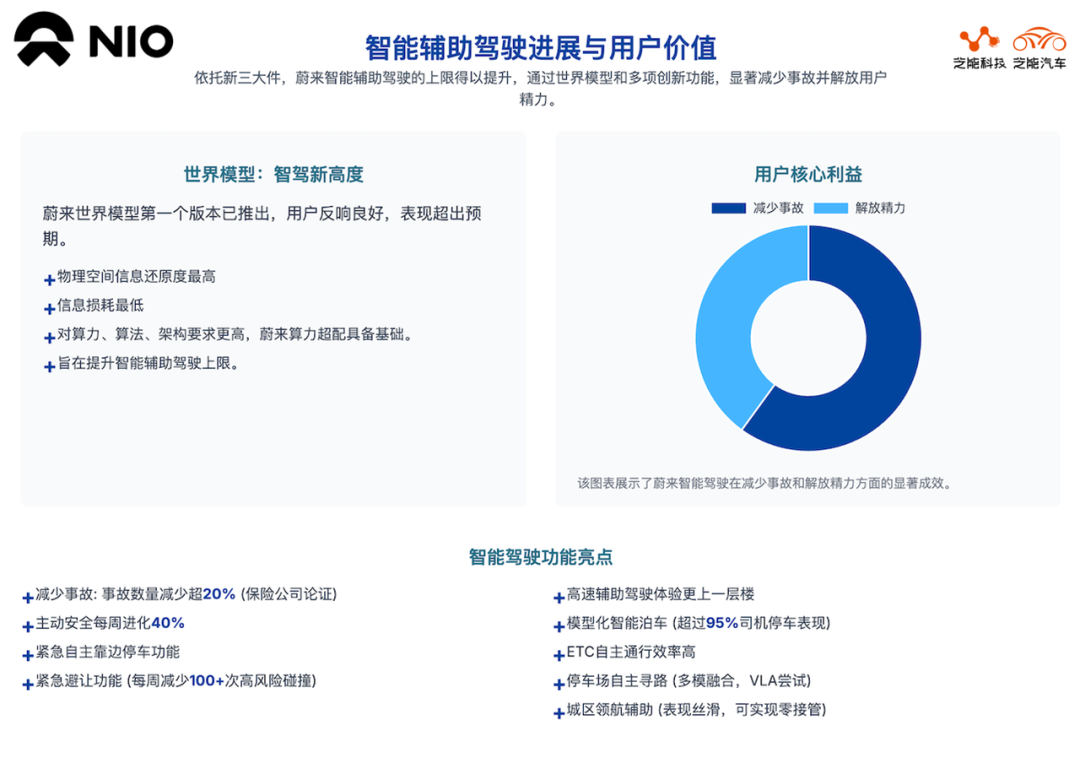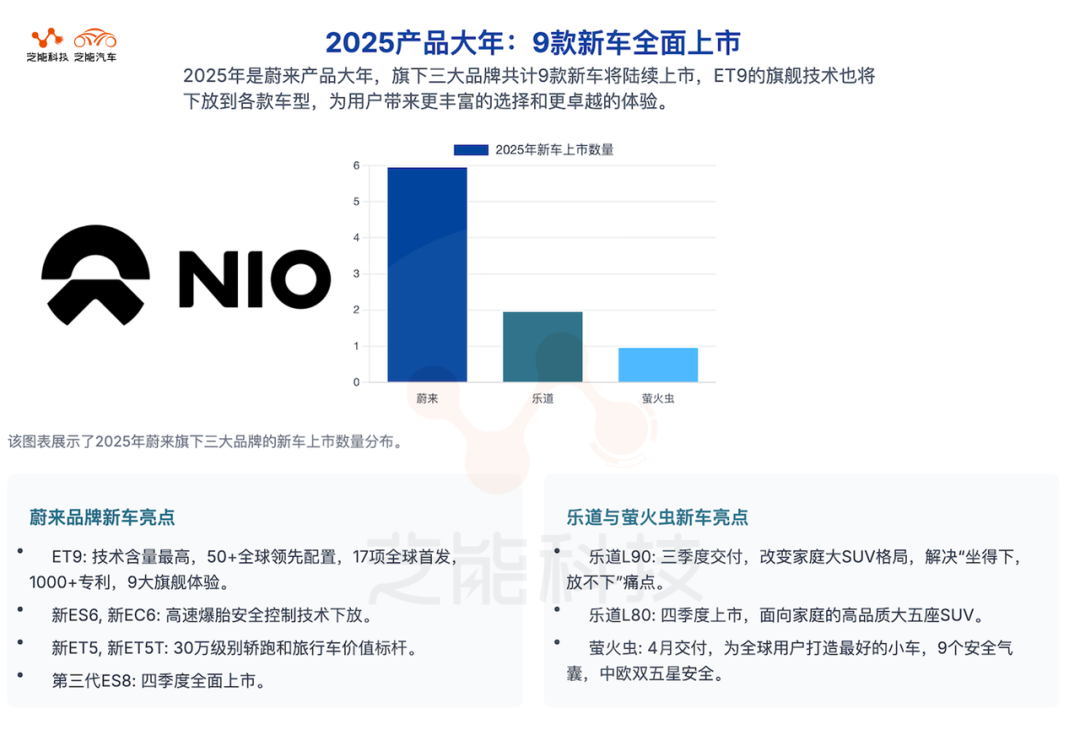NIO's Transformational Moment: Shifting from Full-Stack Technology to Agile Organization
![]() 06/04 2025
06/04 2025
![]() 426
426
Produced by Zhineng Technology
At the 2025 Greater Bay Area Auto Show, Li Bin once again captured the industry's spotlight, but this time, the buzzword was not idealism but "synergistic strength."
Amidst the pivotal shift from the "first half" to the "second half" of the smart electric vehicle era, NIO is embarking on a comprehensive reconstruction of its products, technology, and organizational structure. This automaker, once celebrated for its exceptional user experience and brand tone, is now deeply invested in technological autonomy, pioneering the World Model, decentralizing flagship technologies, and reforming its internal structure.
In 2025, amidst relentless industry experimentation and fierce competition, NIO strives to demonstrate that its technological foundation is not a mere spectacle but a structural competitiveness with the resolve and capability to deliver tangible results in mass production and efficiency.

01
From Core Components to the World Model: NIO's "Foundationalism"
In 2025, while many new-energy vehicle brands focused on integrating AI and large language models, NIO quietly sidestepped the hype and unveiled the first version of its World Model.
At the Greater Bay Area Auto Show, Li Bin elucidated the rationale behind this direction: It represents the technical path with minimal information loss and maximal fidelity in spatial intelligence. While it might not be the quickest route to a "demonstration effect," it could be the pivotal lever for long-term advancements in autonomous driving experiences.
NIO's technological strategy is crystallizing.
Li Bin's "new three core components of smart cars" – autonomous driving chips, full-vehicle domain operating systems, and intelligent chassis – are no longer mere slogans. This "full-stack in-house research" system has gradually entered mass production in 2025.
◎ The automotive-grade 5-nanometer chip, exemplified by the Shenji 9031, has already been installed in vehicles, challenging NVIDIA's mainstream platforms with its efficiency of "one chip replacing four." Critically, from the chip to the underlying OS and toolchains, everything is independently developed by NIO, marking a genuine attempt to build from scratch. ◎ NIO has also launched a by-wire steering system certified in both China and Europe, creating a technical edge at the intelligent chassis level. For instance, the flagship model ET9 can adjust its posture 1,000 times per second, 60 times faster than conventional air suspensions. Although initially popularized as a "dancing car," this technology's more practical significance lies in providing robust redundancy and control precision for vehicle stability in extreme scenarios. At the autonomous driving level, NIO's World Model, active safety, and urban NOA have formed a complete closed loop: functions such as active risk avoidance and emergency autonomous pull-over have been automatically optimized weekly, with a reduction of over 20% in safety incidents, gradually becoming core selling points for models like ET5 and ES6. In aspects like parking experiences, automatic ETC passage, and urban detouring, NIO's assisted driving experience mirrors that of an "experienced driver," with some employees completing the entire Shanghai-Hefei journey without manual intervention.
◎ NIO has also launched a by-wire steering system certified in both China and Europe, creating a technical edge at the intelligent chassis level. For instance, the flagship model ET9 can adjust its posture 1,000 times per second, 60 times faster than conventional air suspensions. Although initially popularized as a "dancing car," this technology's more practical significance lies in providing robust redundancy and control precision for vehicle stability in extreme scenarios. At the autonomous driving level, NIO's World Model, active safety, and urban NOA have formed a complete closed loop: functions such as active risk avoidance and emergency autonomous pull-over have been automatically optimized weekly, with a reduction of over 20% in safety incidents, gradually becoming core selling points for models like ET5 and ES6. In aspects like parking experiences, automatic ETC passage, and urban detouring, NIO's assisted driving experience mirrors that of an "experienced driver," with some employees completing the entire Shanghai-Hefei journey without manual intervention.
This is not a gimmick but a signal: NIO is transforming its full-stack R&D accumulation into a "structural moat" for autonomous driving experiences.

02
Agile Architecture and New Brands: Balancing Costs and Sales Volumes

2025 is indeed a "year of products" for NIO.
The NIO brand will introduce six new models, with the Ledao brand planning to deliver the L90 and L80 family-oriented SUVs in the third quarter, while the Firefly, targeting the small car market, commenced deliveries in April.
This signifies a notable expansion of the product line, but behind it, NIO's chosen strategy is not blind expansion but efficiency prioritization.
In the organizational restructuring in May, the frontline personnel of the Ledao brand were reduced by 40%, yet deliveries surged by over 40% year-on-year.
This is not merely an encouraging slogan of "more work with fewer people" but a genuine subtraction experiment: Can a leaner human resource structure and faster decision-making efficiency support a broader new product line? Li Bin's answer is that "synergistic strength can begin to form."
This agile approach is also evident in the restructuring of supply chain and platform capabilities.
NIO's approach has shifted from "high-profile and aggressive" to "precise decentralization": Over 50 flagship technologies from the ET9 have begun to trickle down to more mainstream products like the ET5 and ES6, no longer forming an "isolated technological peak." For example, safety control after high-speed tire blowouts, smart parking, and active avoidance functions have become core safety selling points for second-tier models.
More importantly, NIO is no longer hesitant to discuss costs.
◎ Beyond organizational adjustments, starting from the second-generation platform, NIO has placed greater emphasis on the dual goals of "cost control and module reuse." The Ledao L90, the five-seat L80, and the more affordable Firefly are tasked with "expanding the sales base."◎ In terms of battery swapping, NIO has established over 3,300 battery swap stations and completed 75 million battery swaps nationwide, achieving "county-level swappability" in 122 districts and counties in Guangdong. The expansion of charging stations is also accelerating, with 90% of them being utilized by non-NIO owners, turning this network into a new user entry point.
In mid-2025, standing on the cusp of the second half of the smart car era, NIO's choice is not to retrench but to reconstruct.
◎ Technologically, it is accelerating deployment on the foundation of full-stack in-house research, utilizing the World Model to define a higher ceiling for assisted driving;◎ Brand-wise, it is expanding outward through the "NIO-Ledao-Firefly" brand portfolio;◎ Organizationally, it is streamlining, eliminating redundancy, and leveraging digital capabilities to enhance marginal efficiency;◎ Network-wise, it adheres to long-termism, refusing to sacrifice user experience for short-term cost reduction. These actions might not be flashy but signify NIO's transition from a "user-brand-led" new energy vehicle company to a "technology + efficiency composite" vehicle enterprise. In the past, NIO excelled at discussing sentiment and building communities, but now it is beginning to focus on computing power, accounting, and organizational efficiency. Only by meticulously calculating every account and implementing every investment can NIO truly navigate through the second growth curve and the second half of the smart electric vehicle industry.

Summary
In 2025, NIO is no longer a "technological sentiment company" reliant on singular breakthroughs but is embracing reality.
Appendix: NIO's Journey Over the Past Decade:









